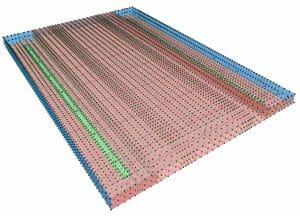Highly specific machines are used in the process of manufacturing or assembling different aircraft parts. Most of these machines are directly supported by the ground, and their type varies depending on their purpose. These new loads can be static or dynamic, which requires designing all the foundational elements needed to properly support them. Almost all of this machinery needs conduits where all the necessary installations will be placed, as well as pits or gradients, depending on the manufacturer, that must be integrated with the new foundations.
Designing a new hangar, or adapting one to new uses, requires a thorough analysis of the loads its surface will bear in order to guarantee its functionality and resistance.
Any new load introduced into an existing foundation requires a thorough analysis to assess its effects. The foundation may not need any changes. Certain elements or machinery to be installed have low loads or low deformation requirements, and thus the existing flooring elements or slabs are sufficient to support them.
But most of the time this is not enough, and another type of solution is required to provide proper support. The machinery used normally has large loads and specific deformation requirements. This determination usually requires new geotechnical readings of the ground where these elements will go, and these readings must include specific parameters in order to accommodate any type of possible solution. The spectrum of possible solutions ranges from long slabs to act as a surface foundation, to deep foundations that rely on piles or micropiles.
Each of these potential foundation solutions has its pros and cons, but one that combines speed, versatility and affordability is a deep foundation based on micropiles.
The complete process involves manufacturing the micropiles, setting up the slab area where these elements will be used, positioning the rails for the machinery and concreting the pits, shafts and other foundation elements.
 The calculations for these special foundations are done using specific structural models, which in most cases rely on finite element analysis.
The calculations for these special foundations are done using specific structural models, which in most cases rely on finite element analysis.
This discretization in the models can yield highly precise results for the stresses and deformations of these elements in the ground.
In most special foundations, the flatness requirements needed to support the machines are set by the manufacturer and are usually very high, meaning any rotation or vertical deformation must be calculated and analysed to ensure it is within the allowed range.
A typically adopted value is to have a vertical deformation limit of 0.1 mm every 2 metres. Associated with this is the maximum permitted angular distortion of any rail, which is αmax. = 0.1/2000 = 5*10-5 rad.
In addition to the ideal foundation, all the metal elements required to either support the machinery or any rails must also be designed.These can be anchor plates or metal rails embedded in the new foundation itself. They will be designed using influence line models to determine what loads will be created by the machinery.
 Models will be created for both static loads, borne by the supports, and dynamic loads, borne by the rails, where the slab support points on micropiles are assumed to be non-deformable articulated fixed supports.
Models will be created for both static loads, borne by the supports, and dynamic loads, borne by the rails, where the slab support points on micropiles are assumed to be non-deformable articulated fixed supports.
The vertical deformation and angular distortion are calculated for each rail to verify that they are within the limits set by the manufacturer. Graphs are produced for quick viewing during the validation, or to determine if the thickness of the slab or the cross-section of the metal profile needs to be increased, or if the grid of micropiles needs to be tightened.
 The final finish of these new installations is integrated into the rest of the building, with the final tasks being levelling and painting the work area.
The final finish of these new installations is integrated into the rest of the building, with the final tasks being levelling and painting the work area.
 Making a new foundation in a hangar or building in use is always a challenge, from both a production and technical standpoint. Doing so while minimizing the level of noise and dust is always a challenge in itself, one that is compounded by the high flatness requirements that these elements must have in order to be able to manufacture or assemble the different aircraft parts.
Making a new foundation in a hangar or building in use is always a challenge, from both a production and technical standpoint. Doing so while minimizing the level of noise and dust is always a challenge in itself, one that is compounded by the high flatness requirements that these elements must have in order to be able to manufacture or assemble the different aircraft parts.


